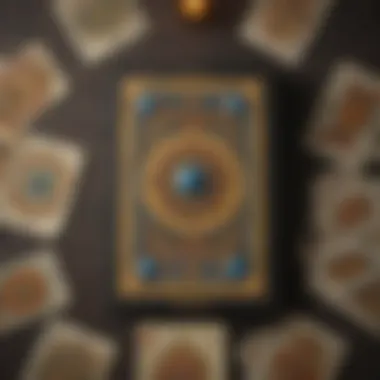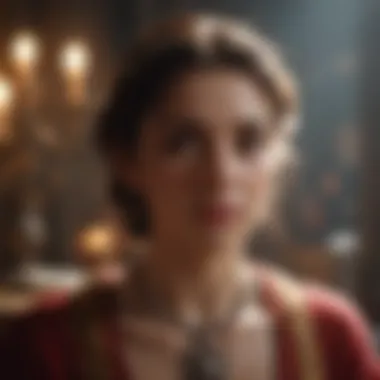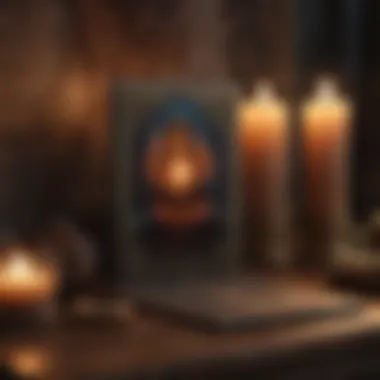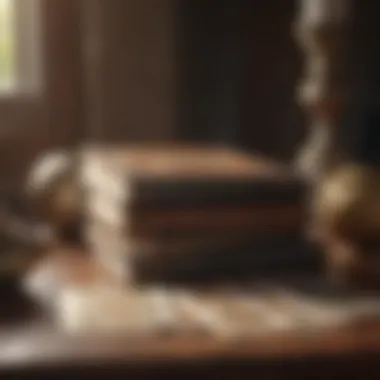Exploring the Depths of Guided Tarot Books


Intro
Guided tarot books serve as essential tools for both novices and seasoned practitioners of tarot reading. They function not only as traditional instructional manuals but also as repositories of wisdom, bridging the gap between ancient knowledge and contemporary application. Each book typically encompasses structured content, diverse themes, and varied methodologies that facilitate an enriched understanding of tarot.
In this article, we aim to explore the significance of guided tarot books in various contexts. The structured nature of these texts often aids learners in breaking down complex concepts into digestible parts. For beginners, the journey into the world of tarot can feel overwhelming, which is why these resources are invaluable. They provide a clear pathway through the intricate landscapes of tarot reading, allowing readers to develop their skills systematically.
On the other hand, advanced practitioners can benefit from the nuanced discussions found within the pages of these books. Many guided tarot resources delve into astrological correlations, numerological influences, and psychological interpretations, which serve to enhance the practitioner's readings. This article will also investigate how the content diversity and learning methodologies employed in these books cater to a wide audience.
By synthesizing insights across various dimensions of guided tarot literature, we aspire to inform readers – from eager beginners to adept tarologists – about effective approaches to harnessing the potential of tarot. Understanding the intricacies of the genre can deepen one's connection to tarot and facilitate personal growth.
The impact of guided tarot books is multifaceted, enabling practitioners to engage more deeply with the cards and their meanings. Now, let us turn our focus to the specifics of tarot literature and its characteristics.
Understanding Guided Tarot Books
Guided tarot books play a pivotal role for those who seek to deepen their understanding of tarot reading. These resources provide structured approaches to learning and facilitate the mastery of tarot techniques. As a multifaceted art that blends intuition with learned knowledge, tarot reading can be complex to navigate. Thus, having a guide enhances clarity and confidence in the practice.
When we talk about the significance of guided tarot books, we refer to several key components:
- Learning Styles: Different readers have diverse learning preferences. Guided books cater to visual, auditory, and kinesthetic learners through illustrations, explanations, and practical exercises.
- Structured Learning: Many books are organized in a systematic way, which allows for a progressive understanding of tarot. This increases retention and reinforces learning effectively.
- Improved Interpretative Skills: Through examples and case studies, readers gain insights into interpreting cards within various contexts, enriching their readings.
These considerations highlight that guided tarot books are not just instructional tools; they are vital companions in the tarot learning journey, offering both foundational knowledge and advanced insights for practitioners at every level.
Definition and Purpose
Guided tarot books are instructional materials designed to assist readers in learning tarot. Their primary purpose is to simplify the complexities associated with tarot reading by providing clear explanations of card meanings, spreads, and techniques. Each book typically includes a combination of textual information and visual aids, such as illustrations of tarot cards, to enhance comprehension.
Moreover, these books often aim to fill gaps in a reader’s understanding that can arise from casual readings or online resources. They elevate the learning experience by embedding theory into practice, enabling readers to apply what they have learned in real-life scenarios. Whether someone is a novice looking to start their journey or an advanced reader honing specific techniques, guided tarot books serve a crucial function.
History of Tarot Literature
The history of tarot literature is rich and varied, tracing back several centuries. Initially, tarot cards were used in games and did not have any esoteric significance. The transition to mystical and divinatory uses began in the late 18th century when scholars and practitioners started to explore the spiritual dimensions of these cards from a perspective that merged mysticism with psychology.
Over time, several significant works emerged, influencing the way tarot has been studied. Notable texts like The Book of Thoth by Aleister Crowley and 78 Degrees of Wisdom by Rachel Pollack have established benchmarks in tarot literature. These texts offered interpretations, historical context, and innovative spreads, setting a foundation for contemporary guides.
The modern era has seen an explosion of tarot literature, with many authors and practitioners contributing various flavors and approaches. This diversification reflects not just the growth in popularity of tarot but also the different practices and beliefs surrounding its use.
Core Components of Guided Tarot Books
Guided tarot books serve as essential tools for learners at any stage, providing a structured approach to understanding the complexities of tarot reading. The core components of these books heavily influence how effectively an individual can absorb, comprehend, and ultimately apply the knowledge. This article section will delve into the foundational elements that define guided tarot books, emphasizing their structural characteristics, visual appeal, and the ways they foster reader engagement.
Structure and Layout


The structure and layout of a guided tarot book can significantly impact the learning experience. A well-structured book can lead the reader smoothly from foundational concepts to more advanced techniques. Typically, a guided tarot book will follow a systematic approach, often divided into distinct sections that cover topics such as card meanings, spreads, and interpretation techniques.
The layout should facilitate easy navigation. Ideal books include clear headings, subheadings, and numbered lists that allow readers to quickly locate specific information. For instance, if a learner wants to know about the meaning of the Ace of Cups, having a dedicated section makes it easier to find rather than sifting through a dense narrative.
Another important aspect of layout is the inclusion of summaries at the end of chapters. These summaries can encapsulate key points and reinforce learning, ensuring that readers retain critical information.
The Importance of Visual Elements
Visual elements add significant value to guided tarot books. Diagrams, illustrations, and photographs are more than mere decorations; they serve practical purposes. Each tarot card comes with distinct imagery, which is crucial for interpretation. Books that incorporate high-quality images of card designs aid in recognizing symbols and meanings, enhancing the learning process.
In addition to images of the cards, visual aids such as charts for understanding spreads or interpretative grids can be utilized. These tools become a reference point that allows practitioners to visualize complex concepts, making the learning experience more engaging. The judicious use of color can also align with thematic elements, guiding the reader’s mood and enhancing focus.
Interactivity and Reader Engagement
Interactivity is essential for maintaining reader interest and encouraging active participation. Guided tarot books that include exercises, questions, or prompts encourage readers to reflect on their understanding and apply what they have learned. This could include practices such as journaling about personal readings, or engaging in self-reflection exercises based on card interpretations.
Moreover, some guided tarot books integrate complementary online resources. This may include access to websites, videos, or community platforms like reddit.com, where readers can share experiences or seek guidance. Encouraging interaction not only increases engagement but also fosters a sense of community.
A strong reader engagement strategy can also involve integrating quizzes or self-assessment tools at the end of chapters. This not only reinforces the learning but allows practitioners to assess their progress.
Engaging with guided tarot books should transcend passive reading. The most effective learning occurs when readers are encouraged to actively participate in their journey through tarot.
Types of Guided Tarot Books
In the realm of tarot literature, understanding the different types of guided tarot books is crucial. Each type caters to specific needs and interests of learners at various stages of their tarot journey. This section will explore three prominent categories: beginner-focused guides, advanced techniques and insights, and thematic tarot books. By diving into these categories, readers can assess which type will be most beneficial for their personal growth in tarot reading.
Beginner-Focused Guides
Beginner-focused guides serve as essential resources for those new to tarot. They typically introduce the basics, covering fundamental concepts such as card meanings, spreads, and simple reading techniques. An effective guide for beginners will emphasize clarity and accessibility, often featuring practical advice and easy-to-follow examples.
- Content Structure: These books usually have structured chapters, starting with introductions to the tarot deck, followed by a breakdown of key cards, and finally, simple spreads for practice.
- User-Friendly Language: Authors aim to use straightforward language to ensure that novices can grasp complex ideas without feeling overwhelmed. Having clear explanations is vital.
- Practice Exercises: Many beginner guides include exercises designed to enhance learning and application. These activities encourage readers to engage with the material actively.
It is essential for newcomers to select guides that resonate with their learning style. A supportive guide can significantly ease the transition into tarot reading.
Advanced Techniques and Insights
After mastering the basics, many practitioners seek to deepen their understanding of tarot through advanced techniques and insights. These books are geared towards experienced readers looking to refine their skills or explore new perspectives.
- Complex Card Combinations: Advanced guides often cover intricate interpretations of card combinations and their collective meanings, pushing readers to think critically about readings.
- Psychological and Spiritual Aspects: Authors may delve into the psychological implications of tarot readings or incorporate spiritual philosophies, offering insights into how tarot connects to broader themes in life.
- Innovative Spreads: Readers are introduced to complex and creative spreads tailored for specific types of questions or situations, enhancing their reading versatility.
"Advanced techniques not only boost one's reading skills but also deepen the intuitive aspect of tarot practice."
Thematic Tarot Books


Thematic tarot books focus on specific topics, themes, or populations, making tarot accessible through various lenses. These books cater to diverse interests and can enrich the reader's experience.
- Themes: Common themes include self-care, relationships, or shadow work. Thematic books guide readers to apply tarot insights in targeted aspects of life.
- Cultural Context: Some authors incorporate cultural, historical, or psychological contexts, allowing readers to appreciate the broader implications of tarot symbols and meanings.
- Integration of Other Disciplines: It is common for thematic books to merge teachings from other disciplines like astrology or numerology, providing a multi-faceted approach to tarot.
Choosing the right guided tarot book is not merely transactional; it can be transformative. Understanding the distinctions between these types aids in tailoring the tarot learning experience to individual needs and aspirations.
Choosing the Right Guided Tarot Book
Selecting the right guided tarot book is crucial for anyone wishing to enhance their tarot reading skills. Different books cater to varied levels of expertise, interests, and learning styles. With a vast array of options available, this process can be both exciting and daunting. Understanding how to navigate this selection process can significantly impact your tarot journey.
Assessing Your Skill Level
Before diving into the myriad of guided tarot books, it is essential to assess your own skill level. Are you a complete novice, or do you have some experience with tarot reading? Books designed for beginners often introduce concepts such as card meanings, spreads, and basic reading techniques. These resources might include:
- Clear definitions and explanations of tarot terminology.
- Simple card interpretations to facilitate learning.
- Step-by-step instructions for foundational spreads.
Conversely, if you are more adept in tarot, you may seek advanced texts. These often delve into complex interpretations, intuitive reading methods, or specialized decks. Recognizing whether you need a foundational guide or a book that offers deeper insights allows for a more enriching learning experience.
Exploring Different Authors
Tarot is a diverse field with numerous authors contributing unique perspectives. When choosing a guided tarot book, consider the author’s background and philosophy. Notable authors like Rachel Pollack and Mary K. Greer bring deep insights from their extensive experience in tarot practice. Here are some factors to consider:
- Writing Style: Different authors have varying narrative styles. Some may favor a structured approach, while others encourage a more freeform, intuitive perspective.
- Philosophical Approach: Some authors may emphasize psychological interpretations, while others might focus on esoteric aspects of tarot. Aligning the book’s focus with your interests enhances your connection with the material.
- Target Audience: Ensure the book’s audience matches your level of understanding. Authors typically indicate if their material is suitable for beginners or advanced practitioners.
Reading Reviews and Recommendations
Before making a purchase, taking time to read reviews and recommendations can prove beneficial. Online platforms like Reddit or social media groups often feature discussions regarding various tarot books. Look for insights such as:
- The clarity of explanations provided in the book.
- How well the book engages the reader.
- The overall effectiveness of the practices suggested.
Websites such as Britannica or Wikipedia may also offer summaries or critiques that can guide your decision. By utilizing multiple sources, you gain a well-rounded understanding of the book’s content and relevance to your personal tarot journey.
"Selecting a book that resonates with you is fundamental for a fruitful tarot learning experience. Your choice can shape how you connect with and apply tarot insights."
Implementing Learning from Guided Tarot Books
Implementing learning from guided tarot books is crucial for individuals who wish to translate theoretical knowledge into practical experience. It serves as the bridge between understanding tarot concepts and applying them in real-world readings. Without this integration, the insights gained from reading may remain academic, limiting personal growth and mastery of tarot reading skills. The process of implementing learning can enhance confidence, refine intuition, and promote a more profound connection with the tarot.
Creating a Study Plan
A study plan is the foundation of effective learning in tarot. It helps in organizing content, scheduling practice, and ensuring that the learner covers necessary topics systematically. Begin by assessing the books or resources that are most aligned with your interests and current skill level. This could range from basic understandings of the Major Arcana to advanced spreads for deeper insights. Setting clear, achievable goals is essential. For instance, decide to learn three new card meanings each week or practice specific spreads daily. Consider incorporating diverse methods, such as summarizing chapters after reading or even creating notes for future reference. These habits not only solidify the knowledge but also create an enduring resource for future use.
Incorporating Practice Sessions


Theoretical knowledge in tarot requires practical application for real mastery. Incorporating practice sessions is vital. Practical engagement could involve performing readings for oneself or others, trying different spreads, and reflecting on the outcomes. Establish dedicated practice times, similar to a class schedule. This could be a few times a week or even daily sessions focusing on new spreads or card interpretations. Another effective way is to keep a tarot journal. This journal can detail daily draws, interpretations, and reflections on how they resonated with your day-to-day experiences. Such records will offer insights over time, showcasing your growth and shifts in understanding.
"Practicing tarot is as much about intuition as it is about knowledge. Each reading is a conversation with the cards."
Connecting with Other Tarot Enthusiasts
Engaging with a community can vastly enhance your learning experience. Connecting with other tarot enthusiasts offers support, shared experiences, and diverse perspectives. Consider seeking out local tarot groups, online forums, or social media platforms. Participating in discussions on sites like Reddit can provide additional insights and learning opportunities. You can also join workshops or webinars, which often feature seasoned practitioners willing to share techniques and tips. Collaboration is beneficial. By exchanging feedback on readings or practicing together, you can learn new methods and gain a deeper understanding of the tarot.
The Role of Guided Tarot Books in Modern Tarot Practice
Guided tarot books have become essential tools for many practitioners navigating the complex world of tarot reading today. As tarot continues to grow in popularity, these books act as bridges connecting tradition with contemporary practice. They help readers, both novices and more experienced, grasp the nuances of interpreting the cards more effectively. The fusion of time-honored principles with innovative approaches makes guided tarot literature particularly relevant in modern contexts.
Among the key benefits of guided tarot books is their ability to present structured learning paths. They help demystify tarot by breaking down intricate concepts into digestible segments. This structured approach not only fosters better understanding but also encourages consistent practice, which is fundamental for mastering tarot skills.
Guided tarot literature also often reflects evolving societal attitudes toward spirituality and self-improvement. As more individuals explore personal growth through spirituality, tarot becomes a significant tool for self-reflection and insight. Therefore, guided tarot books play a critical role in facilitating this journey by offering diverse techniques and perspectives.
Adapting to Technology Trends
In the current digital age, technology has significantly influenced how individuals engage with tarot. Guided tarot books have adapted by incorporating various multimedia elements. For instance, many books now include QR codes that link to online resources, such as video tutorials or digital platforms for community engagement. This blend allows readers to access a wider range of learning tools, enhancing their overall understanding of tarot.
Furthermore, many authors have embraced social media to promote their books. Platforms like Facebook and Reddit provide spaces for discussion, allowing readers to connect with authors directly or join communities of like-minded tarot enthusiasts. Such engagement fosters a deeper understanding of concepts presented in the books and creates a supportive network for sharing insights and experiences.
Combining Online Resources with Books
The integration of online resources with traditional books has revolutionized tarot education. Many practitioners now find that combining these two formats leads to a more enriching learning experience. Guided tarot books often recommend websites, forums, or podcasts that echo the teachings within their pages, creating a cohesive learning environment.
This symbiotic relationship serves several functions:
- Extended Learning Opportunities: Readers can take advantage of supplementary materials that delve deeper into specific themes or techniques discussed in their books.
- Real-Time Updates: Online platforms allow authors to provide real-time updates or additional information, ensuring that readers have access to the most current insights.
- Community Engagement: By seeking out online groups or forums, readers can discuss their learnings, ask questions, and gain different perspectives that complement their reading material.
Overall, the combination of online resources with guided tarot books enriches the learner's journey, making tarot more accessible and engaging for a diverse audience. The adaptability of guided tarot literature to the digital landscape not only underscores its relevance in modern practice but also enhances the growth of a vibrant community of tarot readers.
Guided tarot books are not just reading materials; they are entries into the evolving world of tarot understanding.
Finale
The conclusion serves as a critical synthesis of the narrative explored throughout the article. It highlights the relevance and significance of guided tarot books for individuals interested in tarot, regardless of their experience level. By summarizing the essential points discussed in previous sections, the conclusion helps to reinforce the core themes of this study, making the content cohesive and accessible.
Summarizing Key Points
In this article, we have delved deep into various aspects of guided tarot books. Key points to remember include the following:
- Definition and Purpose: Guided tarot books are designed to support individuals either new to tarot reading or those looking to enhance their existing skills through diverse learning methodologies.
- Core Components: The structure, visual elements, and interactive components of these texts play a crucial role in how readers engage with the material.
- Types of Guides: Various types cater to specific interests and skill levels, offering tailored content for both beginners and advanced practitioners.
- Choosing the Right Book: Understanding one’s own skill level and preferences is vital for selecting the appropriate literature.
- Implementation: Creating a study plan, practicing regularly, and connecting with other fans can elevate the tarot learning experience significantly.
- Modern Trends: The integration of technology and online resources signifies an evolving landscape in guided tarot literature.
Future of Guided Tarot Literature
The future of guided tarot literature appears to be promising and diverse. As technology continues to influence the way we learn and share knowledge, it is likely that guided tarot books will adapt and evolve. We might expect:
- Increased Interactivity: Future publications may incorporate more digital elements, allowing for richer, interactive experiences that enhance the learning process.
- Mobile Formats: The shift towards mobile access may lead to the creation of apps and e-books that offer flexibility and instant information retrieval for tarot practitioners.
- Cross-Disciplinary Approaches: Merging tarot literature with psychology, spirituality, and even art could provide fresh insights and perspectives for readers.







